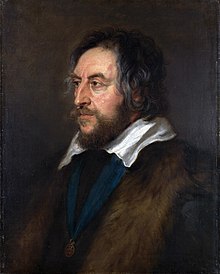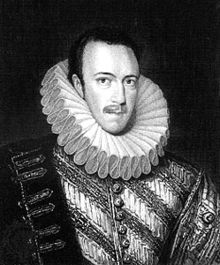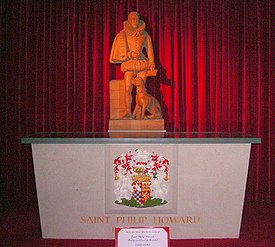|
Philip Howard, 13th Earl of Arundel
 Philip Howard, 13th Earl of Arundel (28 June 1557 – 19 October 1595) was an English nobleman. He was canonised by Pope Paul VI in 1970, as one of the Forty Martyrs of England and Wales. Howard lived mainly during the reign of Queen Elizabeth I; he was charged with being a Roman Catholic, quitting England without leave, and sharing in Jesuit plots. For this, he was sent to the Tower of London in 1585. Howard spent ten years in the Tower, until his death from dysentery. Early lifeThomas Howard, 4th Duke of Norfolk and Mary FitzAlan, Philip's parents   Philip was born at Arundel House, in the Strand, London in 1557, during the upheaval of the English Reformation. He was the only son of Thomas Howard, 4th Duke of Norfolk by his first wife Lady Mary FitzAlan, youngest daughter of Henry FitzAlan, 12th Earl of Arundel and his first wife, Lady Katherine Grey. He was baptised by the Lord Chancellor and Archbishop of York Nicholas Heath at Whitehall Palace with the royal family in attendance, and was named after his co-godfather, King Philip II of Spain, husband of the ruling monarch, Mary I. The baby's other godfather was his grandfather, the 12th Earl of Arundel. His godmother was his great-grandmother, Elizabeth Stafford, widow of the 3rd Duke, who held the child over a gold baptismal font which was kept in the Treasury and normally used only for the baptism of royal children.[1][2] Shortly after his birth, his mother became seriously ill, possibly from puerperal infection and died at Arundel House in August of that year. The illness that caused his mother's death was common due to poor hygiene around childbirth.[3] His home from the age of seven was a former Carthusian monastery.[4] Being the eldest son and heir to the Duke of Norfolk, Philip was destined to become the future 5th Duke. From the moment of his birth, he bore the courtesy title of Earl of Surrey, a subsidiary title of the dukes of Norfolk. In 1569 his father arranged the marriage of Philip to his step-sister Anne Dacre, daughter of Norfolk's third wife, Elizabeth Leyburne, by the latter's previous marriage. Since both children were only 12 years old at the time, the ceremony was repeated two years later, after both parties had attained the age of consent. Philip's half-brothers Thomas and William, sons of their father by his second wife Margaret Audley, subsequently married Anne's sisters Mary and Elizabeth respectively. Philip's father, a Roman Catholic with a Protestant education, was arrested in 1569 for being involved in intrigues against Queen Elizabeth I, mainly because of the Duke's intention to marry Mary I Stewart, Queen of Scots. Although he was released in August 1570, a few months later he became involved in the Ridolfi plot to overthrow Elizabeth, install Mary on the English throne and restore Catholicism, and was arrested again in September 1571, when his participation in the plot was discovered. Norfolk was tried for high treason and sentenced to death in January 1572. He was executed in June of that same year, when Philip was almost fifteen years old. After his father's death, Philip and his surviving half-siblings Thomas, Margaret and William were left in the care of their uncle, Henry Howard, who also took charge of their education. During that time, the Howard children lived with their uncle at Audley End, one of his family's properties. Due to his father's execution, Philip lost much of his paternal family's estates and the title of Earl of Surrey, as the dukedom of Norfolk was forfeit. Although Howard did not manage to recover the dukedom, a few years later he and his younger half-siblings were able to recover part of the forfeited properties.[5] It was during this time that Philip was sent to study at St John's College, Cambridge. While Howard was studying there, his wife came under the protection of Henry FitzAlan, 12th Earl of Arundel, Philip's maternal grandfather.[6] Philip graduated in 1574, aged 17. He began attending Elizabeth I's court by the time he turned eighteen; notably, this was only a few years after his father had been executed for treason against the Queen.[7] His life had been frivolous both at Cambridge and remained so at court, where he nevertheless became a favourite of the Queen, despite Philip's troubled family past.  In July 1578, his maternal aunt Jane FitzAlan died without living descendants, as the only three children she had from her marriage to John Lumley, 1st Baron Lumley all died during infancy. With the death of his aunt, Philip became the sole surviving descendant of his maternal grandfather, and was heir to the earldom of Arundel and its subsidiary titles, and all of FitzAlan's extensive properties in Sussex, including Arundel Castle, the main residence of the FitzAlan family, which later became the principal home of Philip's descendants. After his grandfather's death in February 1580, Howard received the entire inheritance of his maternal family, and the Queen made him Earl of Arundel. Since then the Earldom of Arundel has remained in the hands of the main line of the Howard family, and with the restoration of the Dukedom of Norfolk in 1660, the title remains one of the subsidiary (courtesy) titles of the dukes.[1] Howard is variously numbered as 1st, 20th or 13th Earl of Arundel. This is due to forfeiture losses and subsequent recreations of the title. If taken in a continuous line from the creation of the Earldom in 1138 by King Stephen for William d'Aubigny (d. 1176), Philip's direct ancestor, Howard would be the 20th Earl. Received again into Catholic Church and later imprisonment  Howard was present at a debate in the Tower of London in 1581 between a group of Protestant theologians and the Catholic priests Edmund Campion and Ralph Sherwin. This led him to return to Arundel to think about reconciliation with the Catholic Church, despite the dangers that would entail.[8] Philip was originally baptised as a Catholic and although he received a Protestant education, a vein of Catholicism was never far below the surface, mostly due to the fact that his close relations had remained loyal to the Catholic Church during the Reformation. His maternal grandfather was a staunch Catholic[9] and his father, who had also been educated as a Protestant but was a Catholic, was disgraced for having conspired against Queen Elizabeth with the intention of replacing her with Mary, Queen of Scots and thus restore Catholicism in England. His paternal grandfather, the Earl of Surrey, also fell out of favour and was executed by Henry VIII, partly because he was a Catholic. In 1583, the Earl was suspected of complicity in the Throckmorton Plot.[10] He prepared to escape to the Spanish Netherlands, but his plans were interrupted by a visit from Elizabeth at his house in London and she ordered that he confine himself there. That same year, the Countess of Arundel, without her husband's knowledge and in great fear of his displeasure, secretly returned to the illegal and underground Catholic Church in England. After much effort, she successfully regained her husband's affection. On 30 September 1584,[11] the Earl was secretly received again into the Catholic Church by the Jesuit priest Father William Weston. At the same time, the Earl's younger half-brother, Lord William Howard, was also received into Catholicism.[12] Arundel, while still attending Elizabeth's court, successfully hid his adherence to Catholicism for a time,[13] before withdrawing to his home and attempting to focus on being a better husband and father. The next year, Howard acted against Father Weston's cautions,[14] by attempting to flee to mainland Europe in order to live openly as a Catholic with his wife and children.[15] His flight abroad was recommended, planned, and betrayed to Sir Francis Walsingham by a trusted servant, whom Father Philip Caraman identifies as the Earl's chaplain, underground Catholic priest and agent provocateur Father Edward Grately.[16] While many other recusants had been able to successfully flee England, the Earl of Arundel, through his kinship to the late Anne Boleyn, was a second cousin once removed of the Queen. He was widely considered by persecuted Catholics who were plotting regime change to be a possible heir presumptive to the English throne.[17] The Earl's ship was accordingly attacked and boarded by English pirates working for the Tudor Navy while setting sail from Littlehampton. The Earl, who was at first led to believe that the pirate captain only wanted to extort a ransom, was instead arrested and committed to the Tower of London on 25 April 1585.[18][1] He was charged before the Star Chamber with being a Catholic, quitting England without leave, sharing in Jesuit plots, and claiming the title Duke of Norfolk in defiance of his father's attainder. On 17 May 1586, he was fined £10,000 and sentenced to imprisonment at the Queen's pleasure.[19] In July 1586 he was offered his freedom if he would carry the sword of state before the Queen to church; he refused. In 1588 he was accused of praying, together with other Catholics, for the victory of the Spanish Armada. He was tried for high treason on 14 April 1589 and was found guilty. He was immediately condemned to death[15] and attainted, with all his titles and property declared forfeit to the Crown.[20] In a letter dated 1 May 1589 to Claudio Aquaviva, Father Henry Garnet recalled, "When the sentence was pronounced and the crowd saw the Earl coming out of the hall with the axe-edge turned in towards him -- in the trial of nobles this is the sign that the prisoner has been condemned -- suddenly there was a great uproar that was carried miles along the river bank, some people demanding what had come of the Queen's clemency that such a splendid and gallant gentleman should suffer condemnation, others passionately indignant that a man who had prayed to God should be executed for that alone. For among the accusations brought against him, the principal charge and the one on which the whole case turned, was this -- he had asked a certain priest to pray for the success of the Spanish fleet; whereas in fact, all his enemies could prove against him and all he had done was this, that he sought that prayers should be said every day and night in the Tower of London and in other prisons at that time, chiefly, when everyone was expecting a general massacre [of Catholics]."[19] Queen Elizabeth did not sign his death warrant, but Howard was never told this.[18] He was kept constantly in fear of execution, although comforted by the companionship of a dog, which served as a go-between by which Howard and other prisoners, most notably the priest Robert Southwell, could smuggle messages to each other. Although these two men never met, Howard's dog helped them to deepen their friendship and exchange encouragement in each other's plight. Philip Howard loved his pet, which is remembered along with him in a statue at Arundel Cathedral.[21][7] One day Howard scratched into a wall of his cell the words, still visible today: (Latin: Quanto plus afflictiones pro Christo in hoc saeculo, tanto plus gloriae cum Christo in futuro) ("The more affliction [we endure] for Christ in this world, the more glory [we shall obtain] with Christ in the next") (cf. Romans, chapter 8).[18][22] That same phrase is also found today on one of the steps of Howard's shrine in Arundel.[23] Each day he spent several hours in prayer and meditation; he was noted for his patience in suffering and courtesy to unkind keepers.[8] Howard spent more than ten years in the Tower. Father Weston later recalled, "While he was enduring these cruel sufferings an offer of liberation was made him in the Queen's name, but on condition that he held a disputation with the so-called Archbishop of Canterbury. This he refused to do. He preferred to be afflicted in the company of God's people than to possess the passing pleasures of temporal freedom. Indeed, he reckoned persecution a greater happiness than the frail and shallow satisfaction of worldly well-being."[24] Death and burialDuring the autumn of 1595, while dying of dysentery, the Earl petitioned the Queen to be allowed to see his wife and his son, who had been born after his imprisonment. The Queen responded, "If he will but once attend the Protestant Service, he shall not only see his wife and children, but be restored to his honours and estates with every mark of my royal favour". To this, Howard is said to have replied: "Tell Her Majesty if my religion be the cause for which I suffer, sorry I am that I have but one life to lose". He remained in the Tower, never seeing his wife or son again, and died alone on Sunday 19 October 1595.[18] Father Weston later recalled, "There were some who thought he was carried off by poison. I, however, made careful inquiries of a certain Catholic who had served him as a page at that time in the Tower, but I was never able to get any confirmation of this. As he lay dying he bequeathed to me the breviary which he used: but Father Garnet decided to keep it himself for posterity like some religious object. He did not dare to entrust it to me, for everything I had was likely to be seized at any moment, and he did not think it right to expose to such manifold risk a possession which, he declared, was more precious than gold."[24] According to Father Philip Caraman, Garnet also kept the breviary which Robert Southwell had used in the Tower of London. Both, however, were lost in a raid by priest hunters on Garnet's London safe house.[25] Howard was buried beneath the floor of the church of St Peter ad Vincula, inside the walls of the Tower, where his father's remains also lay. The Earl's funeral and burial, according to Father Caraman, "cost his frugal Sovereign two pounds."[26] The Countess of Arundel took a vow of chastity after being widowed, and never remarried. She spent her remaining days writing Christian poetry, attending mass, and making other religious observances. She had a passion for helping those in need, especially the sick.[27] In 1624, the dowager Countess and their son obtained permission from King James I to move Howard's remains, first to the residence of the dowager Countess at West Horsley, Surrey, and finally to the Fitzalan Chapel at Arundel Castle in Sussex.[26] The Dowager Countess died of natural causes on 19 April 1630 at Shifnal Manor, Shropshire aged 73, and was buried next to her husband inside the Fitzalan Chapel. Even though Howard had been attainted at his trial in 1589, in 1603, shortly after the accession of the Scottish king James VI and I to the English throne and thanks to the intercession of Philip's uncle, the Earl of Northampton, Thomas Howard, Lord Maltravers, Arundel's son, was able to regain royal favour. In 1604, Thomas recovered the earldom of Arundel and estates.[15] Legacy
Along with Our Lady of the Assumption, St. Philip Howard is co-patron of the Diocese of Arundel and Brighton.[4] Arundel Cathedral, originally dedicated to St. Philip Neri, was commissioned by the 15th Duke of Norfolk in 1868. It was elevated to the status of a cathedral in 1965 and its dedication changed to Our Lady and Saint Philip Howard just after Pope Paul VI canonised the Earl as one of the Forty Martyrs of England and Wales in October 1970. On 10 March 1971 in the presence of Monsignor Michael Bowen, then Coadjutor bishop of Arundel and Brighton, and the Chapter of Canons, Howard's remains were moved from the Fitzalan Chapel to the new shrine erected in the cathedral, where the consecration ceremony was held.[28][7] Since then, the shrine has become a place of pilgrimage. While imprisoned, Howard spent much of his time writing and translating Catholic poetry and devotional literature. The manuscripts, according to Father Caraman, were routinely smuggled out of the Tower of London to be edited and corrected by Father William Weston,[29] before in at least one case, being smuggled to the Spanish Netherlands for publication by exiled English recusant Richard Verstegan.[30] For example, the Earl made a Latin-Elizabethan English translation of An Epistle in the Person of Jesus Christ to the Faithful Soule by John Justus of Landsberg, which was posthumously published at Antwerp (1595, reprinted 1871). Howard's verse translation of Marko Marulić's poem Carmen de doctrina Domini nostri Iesu Christi pendentis in cruce ("A Dialogue Betwixt a Christian and Christ Hanging on the Crosse"), served in lieu of an introduction in the Antwerp edition.[31] Howard's poetry translation of Marulić was published again, with updated English orthography, in the March/April 2022 issue of the Traditionalist Catholic literary magazine, St. Austin Review.[32] Howard also authored three manuscript treatises On the Excellence and Utility of Virtue.[15] Further detailed research about the Earl's life, as well as several of his works of Christian poetry, was collected by the poet Louise Imogen Guiney and published as part of her 1939 collection The Recusant Poets.[33] See also
References
Sources
|
||||||||||||||||||||||||||||||||||||||||



